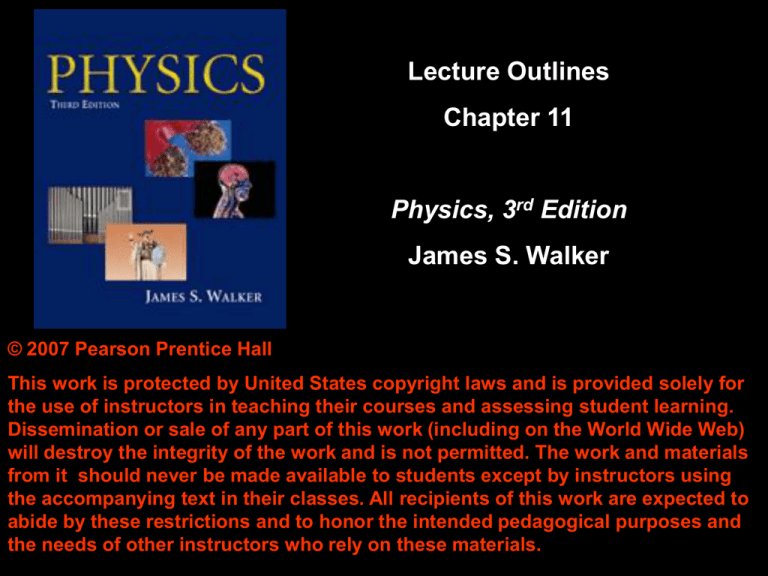
Lecture Outlines
Chapter 11
Physics, 3rd Edition
James S. Walker
© 2007 Pearson Prentice Hall
This work is protected by United States copyright laws and is provided solely for
the use of instructors in teaching their courses and assessing student learning.
Dissemination or sale of any part of this work (including on the World Wide Web)
will destroy the integrity of the work and is not permitted. The work and materials
from it should never be made available to students except by instructors using
the accompanying text in their classes. All recipients of this work are expected to
abide by these restrictions and to honor the intended pedagogical purposes and
the needs of other instructors who rely on these materials.
Chapter 11
Rotational Dynamics and
Static Equilibrium
Units of Chapter 11
• Torque
• Torque and Angular Acceleration
• Zero Torque and Static Equilibrium
• Center of Mass and Balance
• Dynamic Applications of Torque
• Angular Momentum
Units of Chapter 11
• Conservation of Angular Momentum
• Rotational Work and Power
• The Vector Nature of Rotational Motion
11-1 Torque
From experience, we know that the same force
will be much more effective at rotating an
object such as a nut or a door if our hand is not
too close to the axis.
This is why we have
long-handled
wrenches, and why
doorknobs are not
next to hinges.
11-1 Torque
We define a quantity called torque:
The torque increases as the force increases,
and also as the distance increases.
11-1 Torque
Only the tangential component of force causes
a torque:
11-1 Torque
This leads to a more general definition of torque:
11-1 Torque
If the torque causes a counterclockwise angular
acceleration, it is positive; if it causes a
clockwise angular acceleration, it is negative.
11-2 Torque and Angular Acceleration
Newton’s second law:
If we consider a mass m rotating around an
axis a distance r away, we can reformat
Newton’s second law to read:
Or equivalently,
11-2 Torque and Angular Acceleration
Once again, we have analogies between linear
and angular motion:
11-3 Zero Torque and Static Equilibrium
Static equilibrium occurs when an object is at
rest – neither rotating nor translating.
11-3 Zero Torque and Static Equilibrium
If the net torque is zero, it doesn’t matter which
axis we consider rotation to be around; we are
free to choose the one that makes our
calculations easiest.
11-3 Zero Torque and Static Equilibrium
When forces have both vertical and horizontal
components, in order to be in equilibrium an
object must have no net torque, and no net force
in either the x- or y-direction.
11-4 Center of Mass and Balance
If an extended object is to be balanced, it must
be supported through its center of mass.
11-4 Center of Mass and Balance
This fact can be used to find the center of mass
of an object – suspend it from different axes and
trace a vertical line. The center of mass is where
the lines meet.
11-5 Dynamic Applications of Torque
When dealing with systems that have both
rotating parts and translating parts, we must be
careful to account for all forces and torques
correctly.
11-6 Angular Momentum
Using a bit of algebra, we find for a
particle moving in a circle of radius r,
11-6 Angular Momentum
For more general motion,
11-6 Angular Momentum
Looking at the rate at which angular momentum
changes,
11-7 Conservation of Angular Momentum
If the net external torque on a system is zero,
the angular momentum is conserved.
The most interesting consequences occur in
systems that are able to change shape:
11-7 Conservation of Angular Momentum
As the moment of inertia decreases, the
angular speed increases, so the angular
momentum does not change.
Angular momentum is also conserved in
rotational collisions:
11-8 Rotational Work and Power
A torque acting through an angular
displacement does work, just as a force
acting through a distance does.
The work-energy theorem applies as
usual.
11-8 Rotational Work and Power
Power is the rate at which work is done, for
rotational motion as well as for translational
motion.
Again, note the analogy to the linear form:
11-9 The Vector Nature of Rotational
Motion
The direction of the angular velocity vector is
along the axis of rotation. A right-hand rule gives
the sign.
11-9 The Vector Nature of Rotational
Motion
A similar right-hand rule gives the direction of
the torque.
11-9 The Vector Nature of Rotational
Motion
Conservation of angular momentum means that
the total angular momentum around any axis
must be constant. This is why gyroscopes are
so stable.
Summary of Chapter 11
• A force applied so as to cause an angular
acceleration is said to exert a torque.
• Torque due to a tangential force:
• Torque in general:
• Newton’s second law for rotation:
• In order for an object to be in static equilibrium,
the total force and the total torque acting on the
object must be zero.
• An object balances when it is supported at its
center of mass.
Summary of Chapter 11
• In systems with both rotational and linear
motion, Newton’s second law must be applied
separately to each.
• Angular momentum:
• For tangential motion,
• In general,
• Newton’s second law:
• In systems with no external torque, angular
momentum is conserved.
Summary of Chapter 11
• Work done by a torque:
• Power:
• Rotational quantities are vectors that point
along the axis of rotation, with the direction
given by the right-hand rule.






